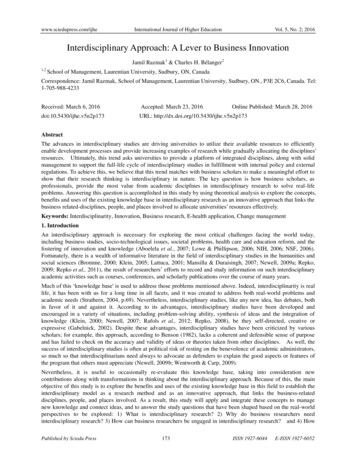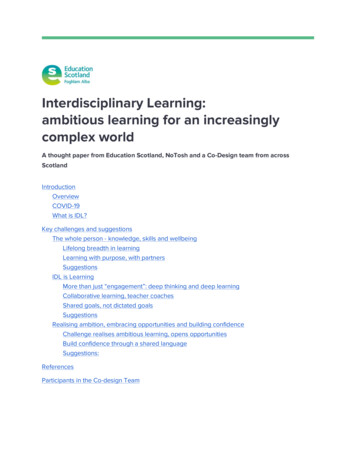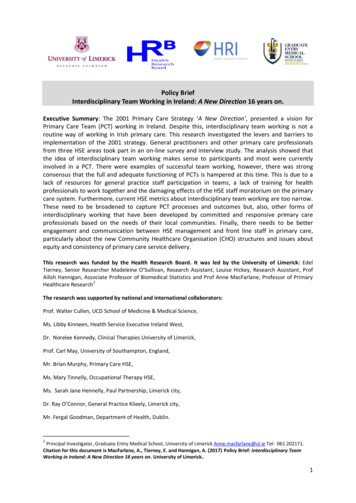
Transcription
www.sciedupress.com/ijheInternational Journal of Higher EducationVol. 5, No. 2; 2016Interdisciplinary Approach: A Lever to Business InnovationJamil Razmak1 & Charles H. Bélanger21,2School of Management, Laurentian University, Sudbury, ON, CanadaCorrespondence: Jamil Razmak, School of Management, Laurentian University, Sudbury, ON., P3E 2C6, Canada. Tel:1-705-988-4233Received: March 6, 2016Accepted: March 23, 2016Online Published: March 28, 2016doi:10.5430/ijhe.v5n2p173URL: http://dx.doi.org/10.5430/ijhe.v5n2p173AbstractThe advances in interdisciplinary studies are driving universities to utilize their available resources to efficientlyenable development processes and provide increasing examples of research while gradually allocating the disciplines’resources. Ultimately, this trend asks universities to provide a platform of integrated disciplines, along with solidmanagement to support the full-life cycle of interdisciplinary studies in fulfillment with internal policy and externalregulations. To achieve this, we believe that this trend matches with business scholars to make a meaningful effort toshow that their research thinking is interdisciplinary in nature. The key question is how business scholars, asprofessionals, provide the most value from academic disciplines in interdisciplinary research to solve real-lifeproblems. Answering this question is accomplished in this study by using theoretical analysis to explore the concepts,benefits and uses of the existing knowledge base in interdisciplinary research as an innovative approach that links thebusiness related-disciplines, people, and places involved to allocate universities’ resources effectively.Keywords: Interdisciplinarity, Innovation, Business research, E-health application, Change management1. IntroductionAn interdisciplinary approach is necessary for exploring the most critical challenges facing the world today,including business studies, socio-technological issues, societal problems, health care and education reform, and thefostering of innovation and knowledge (Aboelela et al., 2007; Lowe & Phillipson, 2006; NIH, 2006; NSF, 2006).Fortunately, there is a wealth of informative literature in the field of interdisciplinary studies in the humanities andsocial sciences (Bromme, 2000; Klein, 2005; Lattuca, 2001; Mansilla & Duraisingh, 2007; Newell, 2009a; Repko,2009; Repko et al., 2011), the result of researchers’ efforts to record and study information on such interdisciplinaryacademic activities such as courses, conferences, and scholarly publications over the course of many years.Much of this ‘knowledge base' is used to address those problems mentioned above. Indeed, interdisciplinarity is reallife, it has been with us for a long time in all facets, and it was created to address both real-world problems andacademic needs (Strathern, 2004, p.69). Nevertheless, interdisciplinary studies, like any new idea, has debates, bothin favor of it and against it. According to its advantages, interdisciplinary studies have been developed andencouraged in a variety of situations, including problem-solving ability, synthesis of ideas and the integration ofknowledge (Klein, 2000; Newell, 2007; Rafols et al., 2012; Repko, 2008), be they self-directed, creative orexpressive (Gabelnick, 2002). Despite these advantages, interdisciplinary studies have been criticized by variousscholars; for example, this approach, according to Benson (1982), lacks a coherent and defensible sense of purposeand has failed to check on the accuracy and validity of ideas or theories taken from other disciplines. As well, thesuccess of interdisciplinary studies is often at political risk of resting on the benevolence of academic administrators,so much so that interdisciplinarians need always to advocate as defenders to explain the good aspects or features ofthe program that others must appreciate (Newell, 2009b; Wentworth & Carp, 2009).Nevertheless, it is useful to occasionally re-evaluate this knowledge base, taking into consideration newcontributions along with transformations in thinking about the interdisciplinary approach. Because of this, the mainobjective of this study is to explore the benefits and uses of the existing knowledge base in this field to establish theinterdisciplinary model as a research method and as an innovative approach, that links the business-relateddisciplines, people, and places involved. As a result, this study will apply and integrate these concepts to managenew knowledge and connect ideas, and to answer the study questions that have been shaped based on the real-worldperspectives to be explored: 1) What is interdisciplinary research? 2) Why do business researchers needinterdisciplinary research? 3) How can business researchers be engaged in interdisciplinary research? and 4) HowPublished by Sciedu Press173ISSN 1927-6044E-ISSN 1927-6052
www.sciedupress.com/ijheInternational Journal of Higher EducationVol. 5, No. 2; 2016can interdisciplinary research be done in business studies? The study’s approach will be conducted according to thetheoretical background of interdisciplinarity and its applications to the real world of academic research. Section onestarts with a description of the basic concepts of disciplinarity, by illustrating its definitions in various contexts.Section two presents several concepts that are related to interdisciplinary studies: typologies, interdisciplinarylearning, and research methods. Finally, this study will outline and address one practical application ofinterdisciplinary research within business studies.2. Disciplinarity in Business StudiesThe direction of such a study requires that we start thinking of the business disciplines and fields as the source ofinterdisciplinary studies. As we proceed, we must keep in mind that the concept of a discipline is not astraightforward one (Wray, 2003). In general, there are several meanings of discipline whether the language is Latin,English, or else., “but most of these meanings involve some notion of submission to a regularized set of practices, asense of an imposed ordering of life and thought, body and mind” (Chandler, 2009). As a term, "discipline derivesfrom the Latin words discipulus, which means ‘pupil’, and disciplina, which means 'teaching' (noun); related to it isalso the word ‘disciple’ as in the disciples of Jesus" (Clarke, 2013; Krishnan, 2009). As a verb, it means trainingsomeone to follow a rigorous set of instructions, but also punishing and enforcing obedience (Clarke, 2013; Krishnan,2009). The context in which the word discipline is used is important to academic institutions, philosophers,business, political and even social entities. In academic institutions, the term discipline refers to a particular branchof learning or body of knowledge whose defining elements—i.e., phenomena, assumptions, epistemology, concepts,theories, and methods—distinguish it from other knowledge formations (Moran, 2002; Repko, 2008;). That meansdisciplines can be identified at any point in time in terms of a bundle of phenomena studied, and theories andmethods applied (Szostak, 2002a).Focusing on specific words in defining the discipline of business studies may well create a debate in considering thevarious business sectors as a discipline or not. Historically, for example, Vickrey, (1970) has consideredaccounting as a measurement discipline, while Demski (2007) concluded that, at this time, accounting is not anacademic discipline, but is “an ever-narrowing, insular vocational enterprise” (p.8); nevertheless, he further believesthat eventually accounting could and should develop into a discipline. The debate also exists in information systems(IS) around the idea of whether IS should be a discipline, a science or a field. Khazanchi and Munkvold (2000)concluded that IS is “a scientific discipline in contrast to purportedly non-scientific fields” (p. 17). Moving in thisdirection, King (1993) asks, what the IS field is. His answer was ". information systems is probably not even a field[emphasis added], but rather an intellectual convocation that arose from the confluence of interests amongindividuals from many fields .” (p.293). In other sectors, Hunt (1992) views marketing as an applied discipline,Grayson (2002) judges economics as a discipline and even now, some of the business-related disciplines are seekingto discipline themselves (Clark et al., 2016).Generally, some disciplines would be considered to be more useful, more rigorous, more difficult, or more importantthan others (Vick, 2004). As well, some of them are conservative, averse to innovation, and resistant to change(Chettiparamb, 2007; Weingart & Stehr, 2000). As a result, according to Chettiparamb, disciplines are drawing theirboundaries too narrowly, restricting innovation and creativity, and limiting reflexivity and engagement withreal-world problems, as well as with other disciplines. Implicitly, the appearance of interdisciplinarity may be seen asa response to the perceived limitations of disciplinarity (Chettiparamb, 2007; Klein, 2006; Shailer, 2005; Szostak,2002b; Weingart & Stehr, 2000). Finally, business disciplines need to develop the current situation and produce aninnovative research that has the ability to develop Social Sciences and Humanities disciplines by integrating themand maximizing the give-and-take among them. Like any innovation, some people will welcome new development,while others will resist it by arguing that everything is right the way it is now (Chandler, 2009), but the nature ofreal-life problems with the flexibility of interdisciplinary studies will ultimately dominate. Therefore, the nextsection will explain interdiscplinarity concepts that address the flexibility of using interdisciplinary research byscholars in business studies.3. InterdisciplinarityThe division of disciplines in various branches of universities sets the stage for later advancements in applyinginterdisciplinary studies to most subjects including business studies (Newell, 2008). Interdisciplinary studies haveconsiderably changed the way that students and teachers do things, including completing their studies, research, andteaching. They are also an interesting approach that could become a goal for many universities, within differentavailable programs and resources (Graybill & Shandas, 2010). As well, interdisciplinary research has enabledscholars to navigate across disciplines, and help them move from purely academic problems to real-world issuesPublished by Sciedu Press174ISSN 1927-6044E-ISSN 1927-6052
www.sciedupress.com/ijheInternational Journal of Higher EducationVol. 5, No. 2; 2016(Carp, 2001). This will lead us to ask the following questions, with which interdisciplinarians often begin: Whatexactly is interdisciplinarity? Among the various concepts discussed in the literature - interdisciplinary research(National Academies, 2005), interdisciplinary understanding (Mansilla, 2010), interdisciplinary education (Rhoten etal., 2006), and interdisciplinary studies (Repko, 2008) – We prefer to use the interdisciplinary research definitionwhich leads to a more adequate, richer conception of real-world problems.That means there are several definitions to understand in the area of interdisciplinary studies. However, to present afoundation for a discussion of interdisciplinarity, Repko (2008) breaks down the word interdisciplinary into its twoparts: 'inter' and 'disciplinary'. The prefix 'inter' means “between, among, in the midst;” disciplinary means “of orrelating to a particular field of study” or specialization. So a starting point for the definition of “interdisciplinary” is“between fields of study” (Stember, 1991, p. 4). 'Inter' also means “derived from two or more.” In terms of academicinterdisciplinarity, several definitions advanced by academic institutions and scholars are involved. This definition isoffered by the National Academy of Sciences, National Academy of Engineering, and the Institute of Medicine(2005):“Interdisciplinary research is a mode of research by teams or individuals that integrates information, data,techniques, tools, perspectives, concepts, and/or theories from two or more disciplines or bodies of specializedknowledge to advance fundamental understanding or to solve problems whose solutions are beyond the scope of asingle discipline or field of research practice” (p.26).A second definition is offered by Aboelela et al. (2007). These authors have conducted a systematic literature reviewin three bodies of academic literature: business, education and healthcare. They reviewed 14 definitions ofinterdisciplinarity in 42 interdisciplinary research publications, as well, conducted 14 interviews with scholars toarrive at the following definition of interdisciplinary research:“Interdisciplinary research is any study or group of studies undertaken by scholars from two or more distinctscientific disciplines. The research is based upon a conceptual model that links or integrates theoretical frameworksfrom those disciplines, uses study design and methodology that is not limited to any one field, and requires the use ofperspectives and skills of the involved disciplines throughout multiple phases of the research process” (p.341).These definitions draw on many concepts such as disciplinarity, integration, and the need for a more comprehensiveunderstanding. Following the invention of the disciplines in past decades and centuries and the advances ininterdisciplinary learning, integration allows for more comprehensive explanations, particularly due to theincorporation of disciplines' resources and the possible development of new metaphors to produce new knowledge(Repko, 2008). For example, the concept of entrepreneurship is a metaphor that coalesces with many other facets ofbusiness-related fields such as microfinance, innovation and human behaviour patterns.3.1 Typologies of InterdisciplinarityScholars who conduct interdisciplinary research in business studies may or may not distinguish interdisciplinarytypologies. For information purposes, the Organization for Economic Cooperation and Development (OECD)categorizes interdisciplinarity terms into “multidisciplinary,” “interdisciplinary,” and “transdisciplinary.” Generally,to distinguish multidisciplinarity from interdisciplinarity, multidisciplinarity refers to the placing side-by-side ofinsights from two or more disciplines (Repko, 2008) and by aligning skills from these disciplines (Strathern, 2004,p.70). In addition, in the OECD classification, multidisciplinarity was defined as an approach that juxtaposesdisciplines. Accordingly, even when disciplines and academic subjects are aligned, they are in a sequencing mode aswell, or in a coordinating mode (Klein, 2010). This means that multidisciplinarity differs from interdisciplinarity inthat the integration between or within disciplines has been reduced, contributions to individual disciplines are weaker,and there is less engagement with each discipline (Klein, 2010; Knight et al., 2013; Repko, 2008).For those who also distinguish transdisciplinarity from interdisciplinarity, transdisciplinarity is “the application oftheories, concepts, or methods across disciplines with the intent of developing an overarching synthesis” (Lattuca,2001, p. 83). Strathern (2004, p.70) defined trandisciplinarity as “a kind of super-interdisciplinarity” which brings“disciplines together in contexts where new approaches arise out of the interaction between them, but to a heighteneddegree.” In the OECD typology, transdisciplinarity (TD) was defined as a common system of axioms that transcendsthe narrow scope of disciplinary worldviews through an “overarching synthesis,” such as healthcare, education, andmanufacturing industries including construction and auto production (Klein, 2010). Insofar as transdisciplinaritydiffers from interdisciplinarity in theories, concepts, or methods, they are not borrowed from one discipline andapplied to other disciplines that have the same problem (Repko, 2008). Rather, they transcend the narrow scope ofdisciplinary worldviews through an overarching synthesis (Klein, 2010, p.24). Regardless of the taxonomies ofPublished by Sciedu Press175ISSN 1927-6044E-ISSN 1927-6052
www.sciedupress.com/ijheInternational Journal of Higher EducationVol. 5, No. 2; 2016business sectors-- whether scholars consider accounting, marketing and IS as disciplines or not-- the flexibility ininterdisciplinarity taxonomies transcends the narrow scope of these disciplines worldviews through an overarchingsynthesis.3.2 Reasons for Interdisciplinarity in Business StudiesGenerally, in the last century most of the Social Sciences and Humanities disciplines progressed slowly comparedwith the sciences. As well, because of the increased specialization and complexity in modern society, thesedisciplines may not be able to answer complex questions (Klein, 2010). Nevertheless, having an approach thatoffers what is needed when it is needed is critical for an academic decision maker to perform effectively in achallenging academic environment. Insofar as it is not sufficient for academia to offer just any approach, it must alsooffer better and more efficient ones to solve complex and real-world research problems. The real-world researchproblems that scholars address rarely arise within orderly disciplinary categories, and neither do their solutions(Palmer, 2001). The best solution for that is an interdisciplinary approach that our scholars need “to answer complexquestions, solve complex problems, and gain coherent understanding of complex issues that are increasingly beyondthe ability of any single discipline to address comprehensively or resolve adequately" (Repko, 2008, p.3).Technology has also considerably changed the way human beings do things, including research and teaching. Forexample, the field of business and technology studies has an interesting intersection that would be possible withinterdisciplinary ideas. The use of technologies in various branches of psychology and sociology (e.g. organizationalbehaviour and change management) sets the stage for later advancements in applying technology to Social Sciencesand other disciplines such as business (Jasanoff, 2010). The merging of technology with communication is also avital example for an integration process, which enhances interdisciplinary effectiveness. Additionally, the academicpressures of globalization make the interest in interdisciplinary research in business studies an urgent one. Success inthis research will not be guaranteed just by teaching people with an interdisciplinary book or by knowing advantagesand disadvantages of such choices. The business interdisciplinary research needs to play a part in improving itsperformance and productivity by removing silo mentalities and creating winning conditions to innovation.4. E-health Application, Change Management and Human Beings as an Interdisciplinary Problem in BusinessResearchAny research method is a milestone followed by a systematic way of proceeding toward achieving its goal (Chandler,2009). Interdisciplinarians such as Klein (2005) and Newell (2007) as well as Repko (2006, 2008) and Szostak(2002) have offered detailed steps, models, and examples in the conduct of interdisciplinary research with the caveatthat no perfect work would ever use all of the possible outlined elements (Repko, 2006). However, interdisciplinaryresearch should also provide measures of development and the nature of learning, as well as allocate goals that arebetter forecasters of students’ academic requirements. Finally, using an empirical analysis of the systemic approachis very powerful in providing faculties with good information related to the learning patterns of both new andexisting disciplines. Building on these models, the following section will apply Repko’s research model to a casestudy that addresses practical life problems in business research.4.1 Drawing on Interdisciplinary Research Process InsightsStep 1: Define the Problem and Formulate the Focus QuestionFocused on North America (USA and Canada), this case will highlight specialized technology in the healthcareindustry, resource allocations and government policy in the implementation process. This is related to governmentsforcing the implementation process of technology without considering all necessary factors. Focusing on e-healthtechnology, for example, USA and Canada have paid billions of federal funds over the past decade to adopt anElectronic Medical Record (EMR) in their hospitals. To measure the adoption of EMR in hospitals, the HealthcareInformation and Management Systems Society (HIMSS) uses a scale from 0, where no structures for EMR are inplace, to 7, where EMR systems are fully functioning. In 2015, HIMSS reported that 17.3% of 641 hospitals inCanada were at stage 0, and only .02% were at stage 7. In the USA, out of 5460 hospitals, only 2.1% are at stage 0and 4.2% are at stage 7 (HIMSS, 2015). These numbers indicate that there is a complex problem somewhere in theimplementation process of EMR.According to these numbers, this case will address the following questions: Why does North America pay billions but ranks very low in the adoption of EMR? What are the human barriers to adopting EMR in North America? What are the strategies that should be adopted by the healthcare policy makers to lessen these barriers?Published by Sciedu Press176ISSN 1927-6044E-ISSN 1927-6052
www.sciedupress.com/ijheInternational Journal of Higher EducationVol. 5, No. 2; 2016Step 2: Justify Using an Interdisciplinary ApproachMany researchers are interested in interdisciplinary research because they know the limitations of disciplinaryperspective, particularly, when they are dealing with complex and real-life research questions such as health care andhealth policy (Aboelela et al., 2007). Many justifications for poor innovation performance have been proposed overthe years in numerous studies, but these studies have been limited by a lack of sufficient data and information (TheConference Board of Canada, 2013). As well, there are many justifications for using interdisciplinary research forthis poor innovation performance. First, justification is focused on the complexity of this problem and questions thatare proposed in this study, which relate to interdisciplinary definition (Newell, 2007, Repko, 2008). That means thata full understanding of innovative technology identity, policy, human perceptions, or knowledge can be achievedonly by applying and integrating multiple perspectives and ways of thinking. As well, North America is amulticultural area with a mosaic of ethnic characteristics and the engagement of staff vis-a-vis the expansion of EMRhas not received enough attention (Mort & Finch, 2005). A second justification for the interdisciplinary approachoccurs when important phenomena become part of the research problem and are also explored by more than onediscipline. Because of this, various important phenomena and concepts concerning North America EMR becomemore difficult to fully comprehend when approached through the lens of a single discipline. Additionally, this caseand other studies have to use a comparative analysis among North American hospitals to determine the impact ofphysiological, managerial, political and economic practices on the adoption of new technology.Steps 3 and 4: Identify Relevant Disciplines and Conduct a Literature SearchExisting research has claimed that the adoption of EMR is affected by different factors and has also had considerableinfluence on staff practices. Besides these factors, management, technology, and economic policy are the primarydisciplines in this research, but others (such as psychology and sociology) are employed in staff practices. As well,there are integration and overlapping between and within different disciplines and factors. In reality, psychologicalfactors may overlap with the managerial factors (change management) particularly those that are related to humanbehaviour.Steps 5 and 6: Develop Adequacy in Each Relevant Discipline, Analyze the Problem and Evaluate each Insight intoit.The overall perspectives of the related disciplines on EMR are described in the following: The psychological factors affecting staff attitudes to EMRDuring the literature search, medical staff had discussed barriers to e-health by asking various questions concerningmanagerial and psychological behavioural perspectives. Their answers may lead to another motivating question thatwill be interacting with staff attitudes and practices in relation to economic factors, and so on. This means thate-health systems interact with other factors related to human perception, economic policy, and healthcaredecision-making. The impact of managerial practices on the adoption of EMROrganizational change is difficult because people cling to the existing systems. Many decision-makers boast abouthow important their staff are and how they consider them as human capital. Nevertheless, decision-makers haveallocated resources towards acquiring new technologies rather than towards employee development. Changes inmanagement and lack of management coordination may also affect the progress of this technology. For example,McCarter (2009) highlights that there are two agencies in charge of delivering the EMR- e-health Ontario and theMinistry's e-health Program Branch – neither of which, according to McCarter, coordinated or had productiveworking relationships. This was also a consequence of the lack of management coordination and strategic planningprior to the initiation of EMR- e-health projects (Aceti, 2010). As a result, the above has been problematic if notdysfunctional. The impact of political and economic practices on the adoption of EMR.Interestingly, political influences have played a major role in the transition management and implementation oftechnology (Lang & Mertes, 2011). For example, the Guardian News mentioned that the US government’s shutdownof federal departments “would result in hundreds of thousands of federal workers being placed on unpaid leave, afterHouse Republicans refused to pass a budget unless it involved a delay of Barack Obama's signature on healthcarereforms” (Lewis, 2013, p.14). This indicates that there are a significant number of factors that affect the scope ofimplemented e-health programs, such as interest group strength, party politics, economic variables and legislativeprofessionalism (Schmeida et al., 2007). In Canada, some of these political issues rotate around the truth thatPublished by Sciedu Press177ISSN 1927-6044E-ISSN 1927-6052
www.sciedupress.com/ijheInternational Journal of Higher EducationVol. 5, No. 2; 2016e-health succeeds or fails depending on “decisions on access, coverage, spending, pricing, funding, and investment[which] are influenced by political incentives and these can often conflict with rational economic considerations"(Skinner, 2009, p.105). Along with that, the slow progress may also be related to economic factors such as the costeffectiveness of health technologies and health resources allocation (or dis-allocation). The impact of technological usability on the adoption of EMRMany of the other factors recognized by previous studies are related to EMR adoption obstacles. The obstacles arereviewed through the FITT (Fit between Individual, Task and Technology) framework, developed by Ammenwerthet al. (2006). Many of the obstacles noted in previous literature still exist, such as software complexity, useracceptance, and so on. In addition, the obstacles recognized included computer-related characteristics, staff-relatedcharacteristics, and contextual characteristics (Whittaker, 2009). Furthermore, other obstacles imply inconsistenciesbetween the software and procedural workflow. As a result, selected e-health components, and factors related totraining, support, and maintenance may perhaps decrease some of these obstacles (Song et al., 2011).Step 7: Identify Conflicts between Insights and Their SourcesThere is no conflict in the same discipline but possible conflicts exist in some factors between disciplines, such as thefundamentals of assumption, concepts, and theories that are expressed as a disciplinary insight (Repko, 2008). Thesource of conflict is related to the nature of each discipline; for example, in this study the resistance and stress factorsin the psychology discipline may conflict or overlap with the same factors in management discipline particularlywhen applying change management theory. However, the differences in disciplinary assumptions, factors, andtheories related to e-health applications issues will determine the nature of conflict, integration or overlapping.Steps 8 and 9: Create or Discover Common Ground and Integrate InsightsCommon ground is created by modifying the concepts, assumptions and theories that are related to the slow progressof North America EMR technology. According to Repko (2008), common ground is not created by modifying thediscipline’s insights or perspectives. Due to this, creating common ground in this case may not be required betweenmanagement and economics but between psychology, management, and technology. For example, this may beverified through producing an integrated behavioural model by integrating those disciplines; as a result, this modelwill modify the concepts and theories. This exactly matches with the integration description of Newell (2007): "Once common ground has been constructed, the modified insights can be integrated into a more comprehensiveunderstanding of the complex problem.[which] should be responsive to each disciplinary perspective but beholdento none of them" (p. 257, 261).Step 10: Produce an Interdisciplinary Understanding of the Problem and Test ItThere are cognitive, affective and behavioral advancements in the comprehension of EMR technology with eachdiscipline. The final step wil
benefits and uses of the existing knowledge base in interdisciplinary research as an innovative approach that links the business related-disciplines, people, and places involved to allocate universities' resources effectively. . interdisciplinary studies to most subjects including business studies (Newell, 2008). Interdisciplinary studies have










